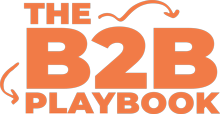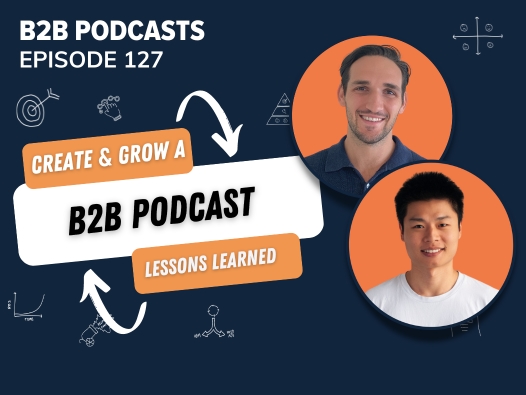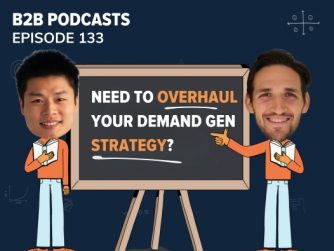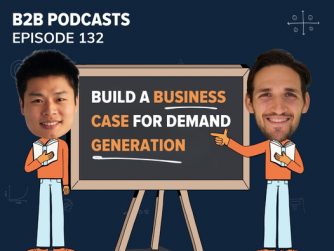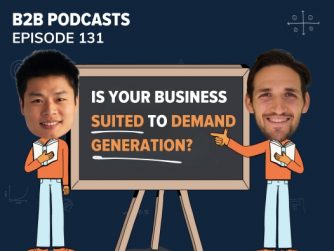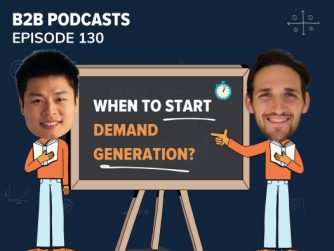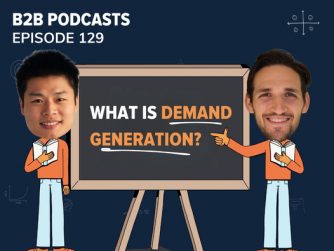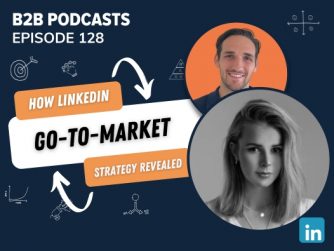Thinking of starting a B2B podcast for your company or personal brand? Or running one currently but it’s not quite living up to the goals you set out to achieve?
Kevin and I have been at it for over 30 months, releasing 130+ episodes of The B2B Playbook, and have been able to attribute $1million+ in pipeline from our own podcast. We’re still growing and learning as fast as we can, but fortunately we’re a far cry from our humble origins.
The journey certainly hasn’t been all sunshine and rainbows. So today we want to share everything we wish we knew before we started our podcast.
Many of these questions have been sourced directly from our audience, so thank you to all those who have reached out.
As always, you can read, watch or listen to below to learn everything we wish we knew about starting, running and growing a B2B podcast.
Listen To The Episode
Watch The Episode
Why You Should Start a Podcast in the B2B World (Benefits)
There are so many incredible benefits to building a podcast in the B2B world. Top of the line, for Kevin and I it has directly driven $1million+ in pipeline, and continues to grow and compound. It’s the best decision we ever made for our business, and the benefits go far beyond attributable revenue.
Some of the other key things it does for us include:
It’s the Core of our Demand Engine
Really, almost all of our business is attributable to the podcast in some way, shape or form. That’s because every piece of content we put out there – be it YouTube videos, LinkedIn posts, articles we write, or Newsletters we send out – is all a derivative of the weekly podcast we record. Our podcast is the pillar piece of content that we then repurpose into all the different ways you see it online and offline. This is a highly efficient form of content creation, allowing us to create an enormous amount of content every week in a fraction of the time it would take someone without this system.
“All business really is attributed to the podcast in some way, shape, or form. It’s either the podcast or LinkedIn or the articles, but these are all derivatives of our episodes that we do here every week on the B2B playbook. So really, we can attribute everything we do, everything we’ve gained to the podcast itself”
George Coudounaris – The B2B Playbook
It’s what builds trust with our Dream Customers and makes them want to work with us. It’s also the reason that we get backlinks to our website, invited to speak on podcasts and at events, and what drives engagement on LinkedIn and in real life.
It Helps Understand and Serve Your Audience
A podcast is an amazing way to deeply understand and serve your audience. It’s not really about you – it’s actually about them. What pains are they facing, and how can you help them overcome them?
“It’s not really about you, in a sense. It’s about your audience, about the audience that you want to reach…what are the issues they’re facing?”
Kevin Chen – The B2B Playbook
You’ll learn so much about your audience or Dream Customers by hosting them on our podcast, or getting their feedback on whatever social platforms you share it on. You’ll be able to read into the numbers to see what resonates and what doesn’t.
It Facilitates Meaningful Conversations
Our podcast also serves as a platform for two-way communication, allowing the us to learn more about our audience and refine our content accordingly. Once we got started it made it so incredibly easy to communicate with our Dream Customers and audience and to learn more about them. We then continuously updated our image of what our Dream Customers looked like, what their core pains were, where it is that hung out online – and fed that information back to improve our podcast and how our business can serve them.
This iterative process of feedback and adaptation is the key to making sure your audience feels heard and engages with you.
It’s A Great Excuse to Talk To Accounts You Want To Do Business With
Is there a key account that you’re trying to get in touch with to win their business? What better way to deepen your relationship with key players than to invite them onto your podcast for a conversation and to show off how amazing they are.
This is a deadly tactic to help execute an account based marketing (ABM) strategy. More on this later. to deepen your relationship with them
What Our Journey Has Looked Like
Kevin and I started our podcast 2.5 years ago, and I cringe pretty hard whenever I catch a sound bite from our first 15 episodes. We were pretty bad. The sound quality wasn’t great. We fumbled our words.
We were even recording in makeshift pillow forts (before A.I. software fixed our voices for us).

But we actually met our first ‘super fan’ in real life by Episode 20. She reached out on LinkedIn to say that she was also from Sydney, and would love to catch up for a coffee if we were around. (Thank you, Ciantal! Your encouragement and assurance we were discussing topics on the podcast that you cared deeply about gave us the energy to keep at it in these initial stages)
Fast forward to now, and we’ve released an episode pretty much every single week for the last 2.5 years. We hopefully sound a lot better. There’s less mumbling. We’re much more confident in our phrasing when discussing and sharing our 5 BEs Framework for Demand Generation.
And most importantly, it’s the core engine that drives our business forward.
Where To Start When Creating a B2B Podcast
There’s so many unknowns when it comes to creating a B2B podcast for the first time. From what topics to cover, what guests to have on, how to grow it – it’s pretty confusing working it all out yourself.
So below is some helpful guidance from our own experience.
How To Decide What To Talk About on Your B2B Podcast
What you talk about on your podcast ultimately depends on what audience you’re trying to reach.
Like any form of marketing, you should tackle an audience that matches your resources and budget. The less budget you have available to push your podcast in front of people, the narrower audience you should try and serve.
Imagine you and I are in a crowded room. You need to shout at me to try and get my attention. Which of these do you think will get me to turn around fastest?
- “Hey, George!” or
- “Hey, George Coudounaris!” or
- “Hey, George Coudounaris from The B2B Playbook!”
Obviously the second should be enough to get me to turn around. But if it’s a family function, who knows how many other George Coudounaris’ are in the room (I am Greek after all).
But the third will definitely capture my attention.
This is exactly why our podcast is not only targeted to B2B marketers, but to:
- B2B marketers, who
- Have limited time and resources, and
- Need to create and execute a demand gen plan for their business
- To drive more revenue
Once you select an audience to target, you need to understand them as deeply as possible. In particular, their pains and anxieties related to the problems you solve.
Your content should address and help them overcome these pains and anxieties. A great mentality to have is ‘Be Helpful’ (which is the 2nd ‘BE’ in our ‘5 BEs Framework’ for Demand Gen.
The topics you cover should also answer questions that your Dream Customers will have along the way on their buying journey. Make sure each piece of content is mapped to our favourite Demand Gen content framework – The 5 Stages of Awareness.
It’s exactly what we’re doing right here for you. We’re providing helpful content to solve your problems. In turn, you develop a relationship of trust with us.
And then, if you ever need our services (like building a Demand Gen program or help running LinkedIn Ads), you see us as the ‘go-to’ expert.
How To Make Your Podcast Engaging
Address Key Pains: Your audience will naturally be more engaged if you’re addressing pain points they care about with solutions that are actionable. You won’t nail this in episode 1. But by starting this journey, you’re initiating a 2-way conversation with your audience / future customers that will enable you to get closer to them as they provide feedback.
“We’re always going back to our dream customers… figuring out what else do they want”
George Coudounaris – The B2B Playbook
Distribute Your Podcast In Different Places: You’ll also get much higher engagement with your podcast if you give your audience lots of different ways to consume it in different places. In our early days, there’d be weeks where we’d struggle to get 50 downloads of our podcast per week. However, we’d still have 1000s of people reading the key ideas and snippets from our podcast when we’d share them on LinkedIn.
Add Video To Your Podcast: Adding video to your podcast is also a natural evolution. This enables you to capture an audience on YouTube or TikTok. The trick here is it’s much harder to keep engagement, because it’s a much higher bar for attention on video.
When people are listening to a podcast, they’re often multi-tasking. They’re running, cleaning the kitchen, listening in the shower (or is that just me), walking to work etc.
We’re still learning how to captivate our audience better with video – but we’ve started adding whiteboard drawings to complement each episode. This visual helps our viewers understand the topics we’re discussing on a deeper level.

It’s not the prettiest, but it’s authentic and maintains engagement.
Use Subject Matter Experts: Subject Matter Experts are going to be able to tell much greater stories and provide better insight for your audience. They also have the benefit of often coming with their own audience and relationships that they can introduce to your podcast.
If you’re selling software to engineers, and you’ve made a podcast for engineers – don’t pretend to be the Subject Matter Expert! Instead, find one internally or externally to your company and have them on the podcast. You can be the facilitator.
Should You Have Guests Or Not?
Kevin and I chose not to be a guest-driven podcast. We have guests on, but only when they can elaborate and provide subject matter expertise in the context of what we’re talking about that season.
For example, Season 1 of the podcast was discussing part 1 of our 5 BEs Framework, which we call ‘BE Ready’. BE Ready is all about deeply understanding your customers. So at the end of the season, we invited customer research expert Ryan Gibson on the podcast to share his approach to customer interviews.
That’s very clearly aligned to the overall theme of the season.
The risk of running a ‘guest only’ podcast is it can be difficult to ensure you are sticking to an overarching theme or purpose of the podcast. You should be strategic about who you select as a guest, and why it’s the right time to have them on in the context of the show.
“We actually aren’t really a guest-driven podcast and I would encourage everyone to not be a completely guest-driven podcast, unless you’re very deliberate”
George Coudounaris – The B2B Playbook
A great framework for considering what guests you should have on the podcast is the ‘3 Circles’. This was introduced to us by Social Media guru Meryoli Arias a few weeks ago when she shared how she drove 400% growth for Apollo.io in just 9 months.

The 3 circles of influence you should consider are: your customers, fans, and employees. We have past customers of The B2B Incubator on our podcast to talk about their success and the pipeline the drove after going through our 12 week program. We also have fans and other influencers on the podcast. And finally, Kevin and myself are always on the podcast (the ’employees’).
How To Measure The Success of Your Podcast?
Success should align with the podcast’s goals, not just traditional metrics like listener numbers. If Kevin and I just went off listener numbers alone, we would have been pretty sad and it would have been hard to justify continuing in year 1!
“If you set out for your podcast to get a whole bunch of listeners, but you don’t already have an existing personal brand…you are going to be bitterly disappointed”
George Coudounaris – The B2B Playbook
The goal of the podcast could be to serve as the core of your Demand Engine. If that’s the case, it becomes less about the number of listeners, and more about:
- Are we easily able to repurpose the podcast into formats our audience can digest?
- Are we getting validation from our audience that they like what we’re talking about?
- Are people mentioning they listen to it when they have a conversation with our sales team?
Another goal could be to network and deepen relationships with key target accounts or influencers in your industry (as part of an Account Based Marketing strategy). If so, the metrics could be:
- How many people agreed to come on our podcast?
- How many did we meet with?
- How many were we able to have a sales meeting with after?
- How many turned into paying customers?
The number of listeners you have does not stop your podcast from achieving its goals.
How to Stay Committed to the Podcast
Kevin and I have been able to deliver almost an episode every single week without fail for 2.5 years because we planned in advance, and built in a lot of processes to make recording and distribution as easy as possible.
However, I don’t recommend you plan your first 100 episodes in advance like we did. Instead, plan 5-10 episodes – just one season to begin with. This sets realistic expectations, avoids burnout, and makes it easier to stay committed in the long run.
We also created processes before, during and after recording to make the process as easy as possible. We create detailed show notes in advance. If we have a guest on, we have a templates with information that we share with the guest before, during and after the recording.
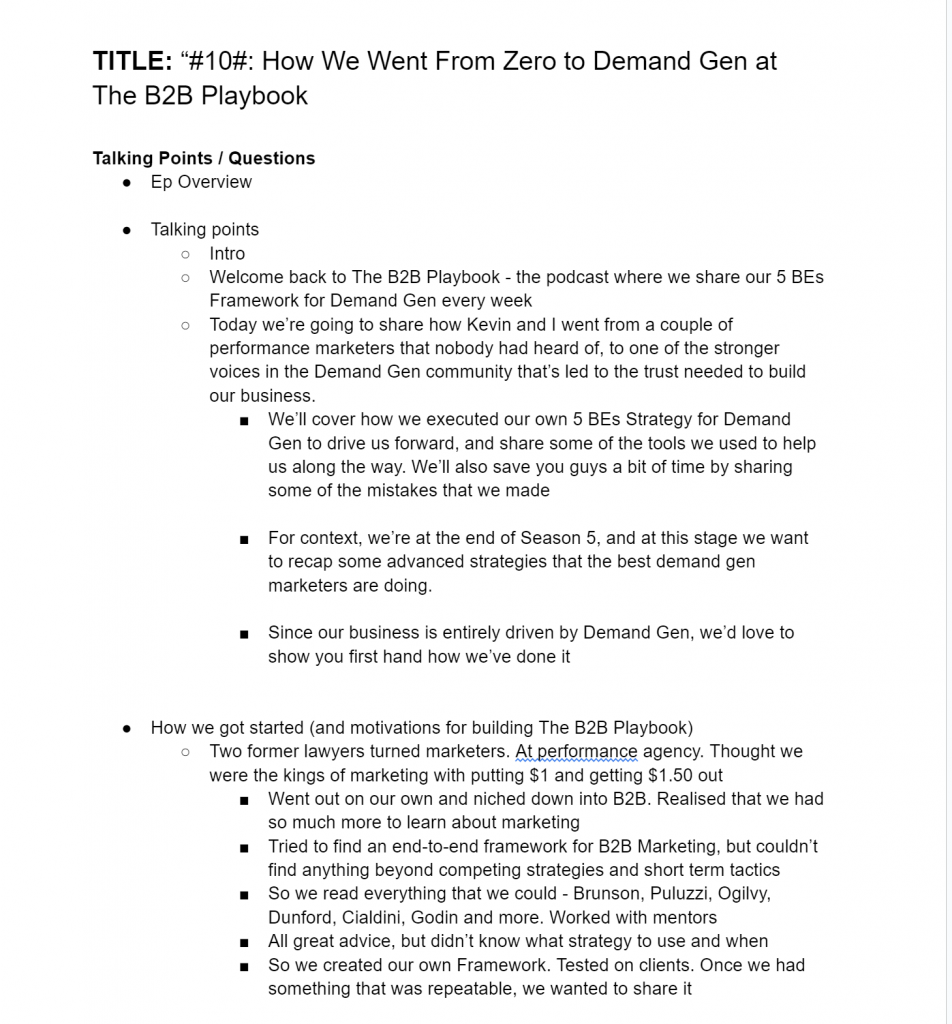
Kevin and I often record multiple episodes in one sitting (this is called ‘batching’), so we always have a few episodes in the bank that we can push live in case we can’t get to recording that week. That way it doesn’t matter if Kevin loses his voice, or I go on holidays – we’re covered and can stick to the planned schedule.
Finally, defining clear success metrics is one of the most important ways to stay committed to a podcast. If listener numbers is all you care about and that’s all you measure yourself on, you’ll likely be disappointed and quit.
How to Get Buy-In from your Boss to Start a Podcast
We’ve covered a fair bit of this already, but here’s some quick tips on how to get buy-in from your boss on creating a podcast:
- Pitch a Limited Series: Shoot for 1 season, with 5-10 episodes. This requires very little budget and time. Promise to measure its success and potential before investing any further
- Show it Can Be Used as an ABM Tool: Show your boss podcasts are a great way of engaging with key accounts you’d love to do businesses with. Important executives don’t want to take sales meetings, but they LOVE being interviewed and shown off to the world.
- Measure Success Correctly: Again, it’s not about listener numbers. Are you using this to connect with accounts? Is it the core of your demand engine? Measure success accordingly
Want To Create a Truly Great Podcast?
We’ve had CMOs, B2B marketing managers and content leads all come through our program The B2B Incubator and build podcasts that drive real revenue for their business.
We give you the strategy, templates and tools to do it all. PLUS you get live sessions with myself to answer any questions you might have.
Save yourself the time of figuring it all out yourself, and check out The B2B Incubator.
Create Your Demand Engine in 12 Weeks
B2B marketing strategy that shows you step-by-step how to drive revenue
